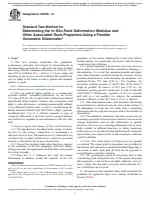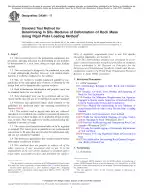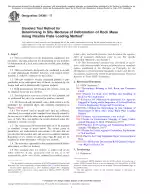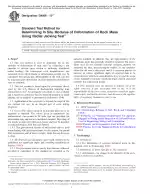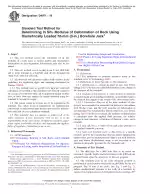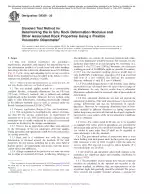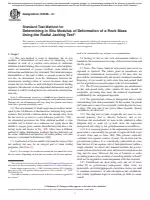ASTM D8359-21 PDF Download
Standard EN SampleStandard Test Method for Determining the In Situ Rock Deformation Modulus and Other Associated Rock Properties Using a Flexible Volumetric Dilatometer
Also Known As:
ASTM D8359-21 is a standard test method that provides guidelines and procedures for determining the in situ rock deformation modulus and other associated rock properties using a flexible volumetric dilatometer. The test method is conducted in an N-size, 75.7 mm (2.98 in.) drill hole and involves the inflation and deflation of the dilatometer hydraulically in the borehole.
The standard emphasizes that while it mainly applies to a commercially available flexible, volumetric dilatometer for the specified borehole size, it could also be used with other dilatometers and different borehole sizes. The use of alternative equipment is considered acceptable as long as it meets the requirements specified in the standard.
The purpose of this test method is to obtain data for the design, construction, or maintenance of structures on or in rock. The test can be conducted in any orientation but is typically performed in vertical or horizontal boreholes as determined by design considerations. There are no depth limitations imposed by the standard, but limitations may arise from equipment capabilities, drill hole quality, and personnel expertise.
It is noted that the test results provide only the average deformation around the borehole and cannot detect significant anisotropy in rock properties caused by factors such as the in situ stress field or fracture density. Additionally, the test is limited by factors such as oversized drill holes or low modulus test intervals, which can result in a limited maximum working pressure and maximum diameter of the dilatometer.
Furthermore, the standard points out that the test does not provide anisotropic properties of the rock mass as it measures only the average deformation and not deformation in specific directions. However, conducting dilatometer tests in boreholes oriented in different directions or obtaining impression packer data in hydraulic-type fractured intervals can provide some insights into the in situ anisotropic conditions.
The standard also includes information on the unit system used (gravitational system of inch-pound units) and guidelines for significant digits and rounding of observed and calculated values, as specified in Practice D6026. These guidelines ensure consistency in data reporting and analysis.
| ICS Codes | 93.020 - Earthworks. Excavations. Foundation construction. Underground works |
| Language(s) | English |
| File Size | 686.1 KB |

